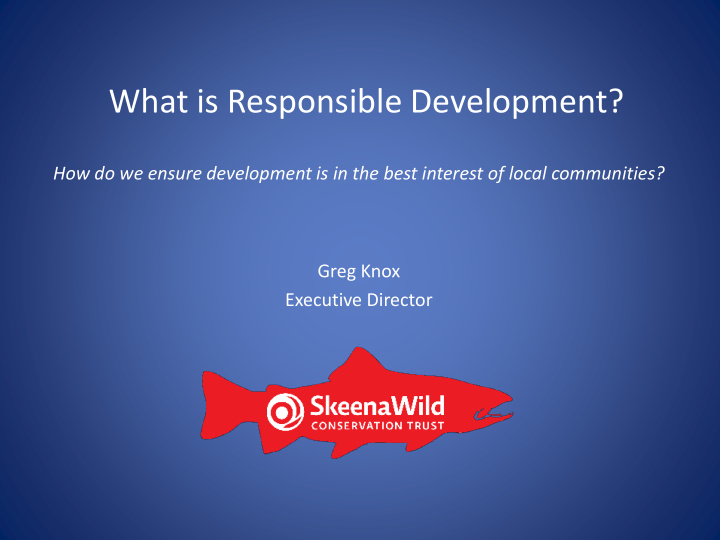



What is Responsible Development? How do we ensure development is in the best interest of local communities? Greg Knox Executive Director
Who we are and what we do
Photo: Ivan Hunter
What type of Development do we support? Asked by the community to talk about what we are for Getting out into local communities • Discuss our approach (based on science, research & best practices) to different resource industries including mining, energy, forestry • Hear peoples perspectives & refine our approach
What does the Community want? Skeena 2050, focus groups and polling Support development as long as it protects our values o Health o Clean air o Clean water o Fish and wildlife o Real benefits to communities
Source: Skeena 2050
Source: Skeena 2050
Making sure we are coming from an informed place
Challenges with the current approach • Insufficient planning • Lack of cumulative effects assessment & management • Lack of revenue sharing • No community input on big decisions • Proponent driven science, assessments and monitoring • Weak laws and regulations • Lack of government capacity – managing, monitoring, enforcement
How do we achieve Responsible Development? Seven aspects we feel are important
1 - Responsible development is well planned This means government , indigenous and local communities playing an active role in determining appropriate sites for developments such as LNG plants. • Instead, the past seven years saw a “Wild West” scenario in which 16 LNG companies proposed 18 liquefaction facilities and 6 pipelines with no coordinated planning.
Creating multiple pipeline corridors with the same origin and terminus poses unnecessary environmental impact. So does siting an LNG plant on top of critical juvenile Salmon habitat in the Skeena estuary. Source: Carrier Sekani Tribal Council
If senior governments provide leadership early on, it not only prevents environmental damage, it also provides greater certainty for proponents. Brian Huntington Photo
Land use planning • LRMP’s, SRMP’s • Gitanyow, Gitwangak, Taku River Tlingit, Great Bear Rainforest • New commitments & initiatives Regional Environmental Assessments Source: Gitanyow hereditary Chiefs
2 - Responsible development is assessed objectively, in the interest of communities and the environment Our environmental assessment process’s have been flawed because they rely mostly on information generated by development proponents themselves, through consultants. – There have been issues with the validity of such information, which undermines the integrity of the assessments. – Information / baseline data is often proprietary and impact assessment methodology often lacks transparency. – Requires fully objective, arms length assessment / review of project impacts. Until now EA’s have not allowed public input on project siting and design – Requires that local communities and indigenous groups have an opportunity to provide feedback before the big decisions are made
B.C .’ s new environmental assessment process and “professional reliance” system.
3 - Responsible development uses industry best practices
4 - Responsible development is properly monitored and enforced
5 - Responsible development keeps a fair share of benefits in the communities where the development takes place The Northwest must be more than a giant funnel that extracts wealth in our region and sends it to southern B.C., with a trickle coming back in the form of grants for which communities must compete. • The Northwest Resource Benefits Alliance – an initiative that aims to gain a fair share for our region’s communities. – every local government from Haida Gwaii to Vanderhoof. • Local procurement • Revenue Sharing agreements with indigenous groups • Agreements must be transparent, provide for community engagement and not be tied to support for the project
6 - Responsible development embraces the shift towards First Nations co-management This is the new reality in our region, a positive one. To fully realize the potential of this shift to co-management, investments must be made to enhance First Nations’ capacity. Requires transparency and accountability Local non-indigenous communities must also have a stronger voice in resource development. Government of Canada Photo
7 - Responsible development takes a long view of the future of our region Boom & Bust Actions today have impacts tomorrow • mid-term timber supply • Diversification is key • tailings ponds for open pit mines • Our opportunities are changing Brian Huntington Photo Gath Lenz Photo
Cumulative effects • New & existing tools • Government (Stewardship Baseline Objectives Tool) • Indigenous initiatives (Environmental Stewardship Initiative) • Salmon Habitat Impact Assessments
The world is changing Climate change is impacting our resources in serious ways Black Press photo Brian Huntington photo
Fossil fuel industry starting to decline
Renewable energy / sustainability issues driving demand for responsible practices Increasing Demands for S&P Global Market Intelligence “green mining”, certified forestry practices
Young people are moving to NW BC
Opportunities to strengthen the NW BC economy Stories of local entrepreneurs and innovators who are un-tapping the potential in our regional economy
Forestry Source: Gitanyow
Kemess underground Kemess Tailing facility Source: Tyee Amazay Lake Source: Hemmera
Questions?
Recommend
More recommend